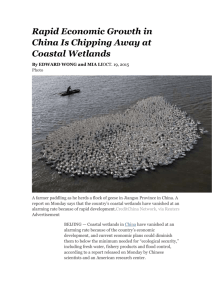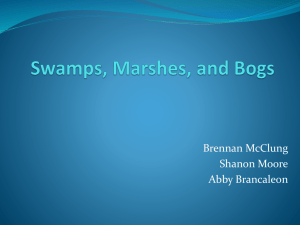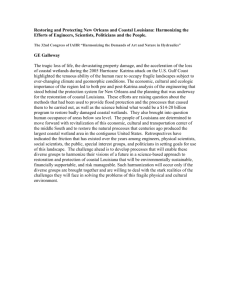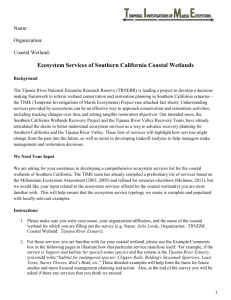Wetlands and carbon - Waquoit Bay National Estuarine Research
advertisement
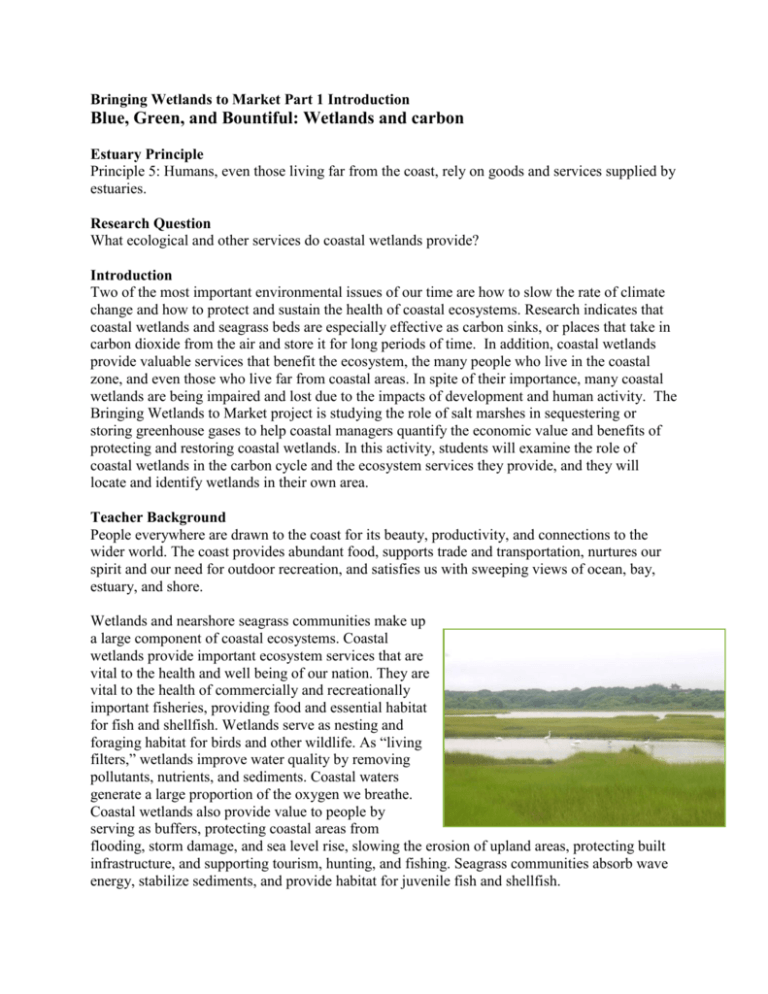
Bringing Wetlands to Market Part 1 Introduction Blue, Green, and Bountiful: Wetlands and carbon Estuary Principle Principle 5: Humans, even those living far from the coast, rely on goods and services supplied by estuaries. Research Question What ecological and other services do coastal wetlands provide? Introduction Two of the most important environmental issues of our time are how to slow the rate of climate change and how to protect and sustain the health of coastal ecosystems. Research indicates that coastal wetlands and seagrass beds are especially effective as carbon sinks, or places that take in carbon dioxide from the air and store it for long periods of time. In addition, coastal wetlands provide valuable services that benefit the ecosystem, the many people who live in the coastal zone, and even those who live far from coastal areas. In spite of their importance, many coastal wetlands are being impaired and lost due to the impacts of development and human activity. The Bringing Wetlands to Market project is studying the role of salt marshes in sequestering or storing greenhouse gases to help coastal managers quantify the economic value and benefits of protecting and restoring coastal wetlands. In this activity, students will examine the role of coastal wetlands in the carbon cycle and the ecosystem services they provide, and they will locate and identify wetlands in their own area. Teacher Background People everywhere are drawn to the coast for its beauty, productivity, and connections to the wider world. The coast provides abundant food, supports trade and transportation, nurtures our spirit and our need for outdoor recreation, and satisfies us with sweeping views of ocean, bay, estuary, and shore. Wetlands and nearshore seagrass communities make up a large component of coastal ecosystems. Coastal wetlands provide important ecosystem services that are vital to the health and well being of our nation. They are vital to the health of commercially and recreationally important fisheries, providing food and essential habitat for fish and shellfish. Wetlands serve as nesting and foraging habitat for birds and other wildlife. As “living filters,” wetlands improve water quality by removing pollutants, nutrients, and sediments. Coastal waters generate a large proportion of the oxygen we breathe. Coastal wetlands also provide value to people by serving as buffers, protecting coastal areas from flooding, storm damage, and sea level rise, slowing the erosion of upland areas, protecting built infrastructure, and supporting tourism, hunting, and fishing. Seagrass communities absorb wave energy, stabilize sediments, and provide habitat for juvenile fish and shellfish. Recent research indicates that coastal wetlands and seagrass communities may capture and store carbon, including carbon dioxide, at rates three to five times greater than forest systems do. They also have the capacity to store carbon over long time periods in their wet, poorly oxygenated soils. That means that they could be extremely valuable as carbon offset areas, which are quantified into shares and traded on global carbon markets. Coastal wetlands may store carbon at rates three to five times greater than forest systems do However, wetlands and seagrass beds are under pressure from development, oversupply of nutrients, and climate change, and these can reduce or wipe out a wetland’s ability to store carbon. Salt marshes, seagrass beds, and mangrove communities could be of tremendous value to the economy of their coastal communities, but only if they are healthy and functioning well ecologically. Climate Extension Because of the connection between atmospheric carbon dioxide and climate change, climate change is an important part of the Bringing Wetlands to Market research project. In this activity, climate change concepts are included in exercises on the carbon cycle and carbon sequestration in wetlands. Table of Contents Teacher guide Exercise 1 Carbon walk Exercise 2 Carbon storage charts Exercise 3 Wetland services and finding a local wetland Teacher guide Blue, Green, and Bountiful: Wetlands and carbon Research Question What ecological and other services do coastal wetlands provide? Content Objectives Students will be able to describe the major reservoirs of carbon in the carbon cycle Students will be able to explain why wetlands and coastal ecosystems are especially useful for carbon sequestration Students will be able to describe the ecological services provided by wetlands Students will locate at least one wetland in their local area Exercises Summary of exercises: Students will make observations and review the carbon cycle, and learn about the capacity of wetlands to store carbon. They will learn about the important ecosystem services provided by coastal wetlands and seagrass systems. Students will use maps and online resources to locate and identify local wetlands. Exercise 1: Students will investigate the carbon cycle and describe where carbon occurs Exercise 2: Students will interpret data and charts to learn about carbon storage in wetlands. Exercise 3: Students will learn about wetland ecosystem services and students will locate a wetland in their local area If you only have time for one exercise We recommend "Wetlands and carbon storage" Next Generation Science Frameworks Life Science 2 Ecosystems: Interactions, Energy, and Dynamics LS2.A: Interdependent Relationships In Ecosystems LS2.B: Cycles Of Matter And Energy Transfer In Ecosystems LS2.C: Ecosystem Dynamics, Functioning, And Resilience LS4.D: Biodiversity And Humans Earth Systems Science 2 Earth’s Systems ESS2.C: The Roles Of Water In Earth’s Surface Processes Earth Systems Science 3 Earth and Human Activity ESS3.C: Human Impacts On Earth Systems Assessment Questions Assessment questions are included as part of student exercises. Vocabulary Carbon : An abundant, nonmetallic element that forms the backbone of organic molecules which are the building blocks for all life Carbon cycle: The exchange of carbon between its main reservoirs—the atmosphere, terrestrial biosphere, ocean, rocks, and sediments. Each of these global reservoirs may be subdivided into smaller pools, ranging in size from individual communities or ecosystems to the total of all living organisms. Carbon dioxide (CO2): A colorless, odorless non–combustible gas that is present in the atmosphere. It is formed by the combustion of carbon and carbon compounds (such as fossil fuels and biomass), by respiration of animals and plants, by the gradual oxidation of organic matter in the soil, and by chemical processes that occur with certain geological components. Carbon sequestration: The uptake and storage of carbon. Trees and plants, for example, absorb carbon dioxide, release the oxygen and store the carbon. Carbon sink: A carbon reservoir that takes in and stores (sequesters) more carbon than it releases. Carbon sinks can serve to partially offset greenhouse gas emissions. Forests and oceans are both large carbon sinks. Carbon source: A reservoir or component of the carbon cycle that releases more carbon than it absorbs. For example, emissions through the burning of fossil fuels are a source of carbon. Climate change The long–term fluctuations in temperature, precipitation, wind, and other aspects of the Earth's climate. Scientists use the term both in reference to natural and anthropogenic (human - caused) change. CO2 equivalent: Wetland ecosystems store carbon, which if disturbed is returned to the atmosphere in the form of carbon dioxide (CO2). The authors use CO2 equivalent as units of measure here because of the emphasis on carbon in the climate system Decomposition: The breakdown of matter by bacteria and fungi. It changes the chemical composition and physical appearance of the materials. It is the process by which carbon is released from decaying biological matter. Ecosystem services – the beneficial outcomes for the natural environment or for people that result from ecosystem functions. Some examples of ecosystem services are support of the food chain, harvesting of animals or plants, clean water, or scenic views. In order for an ecosystem to provide services to humans, some interaction with humans is required. Eelgrass: a marine plant with long ribbonlike leaves that grows in estuaries, brackish inlets, and coastal waters. Flux: (from the root word flow) The rate of exchange of a substance between reservoirs or pools; for example, the rate of exchange of carbon moving from the atmosphere to the soil. Greenhouse gases (GHG): Gases, such as water vapor, carbon dioxide, ozone, nitrous oxide, and methane, which allow solar radiation to pass through to the Earth, but block outgoing longwave radiation. Their action is compared to that of glass in a greenhouse. Hectare: a measure of area equal to about 2.5 acres Mangrove: any of several types of trees up to medium height that grow in saline coastal habitats in the tropics and subtropics. Organic Matter/Organic Material: Anything living or derived from living things, including the dead remains; containing the long chains of carbon atoms characteristic of living things. Photosynthesis: The process by which plants use the energy from sunlight to convert carbon dioxide into organic material, allowing them to grow. Reservoirs: In the context of the carbon cycle, the interconnected areas within the Earth System which store and exchange carbon; includes the atmosphere, the oceans, the terrestrial biosphere, and fossil fuels. Respiration: The process by which living organisms convert organic material into energy needed for living, by taking up molecular oxygen and releasing of carbon dioxide to the atmosphere. Sink: In the context of the carbon cycle, any process by which carbon dioxide is removed from the atmosphere. Soil carbon: A major component of the terrestrial part of the carbon cycle. The amount of carbon in the soil is related to the historical plant cover and productivity, which in turn is dependent in part upon climate variables. Tonnes or metric tonnes: one metric tonne = 1,000 kilograms or about 1.1 US tons
